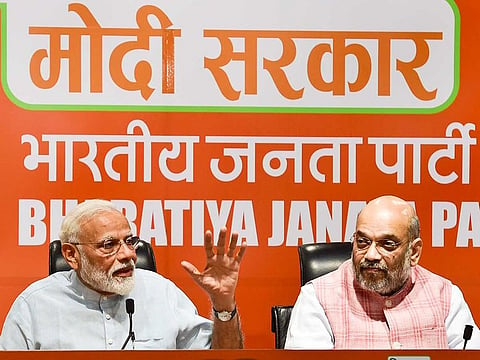Who will be the next PM of India?
Regional parties are expected to corner a big chunk of seats this time

Dubai: As India’s marathon national elections enter the final leg on Sunday, a broad consensus is emerging that electorates are likely to throw up a hung verdict on May 23.
Most observers, including stock market pundits, are bracing for a fractured mandate with no party or alliance breaching the halfway mark of 272 in a house of 543 in Parliament.
On Friday, Prime Minister Narendra Modi appeared confident of a decisive verdict and his colleague Amit Shah said the Bharatiya Janata Party (BJP) will cross 300 on its own, 18 more than it won in 2014. While Indian voters are capable of throwing up surprises, most pollsters and political observers agree that the ruling National Democratic Alliance — of which BJP is the leading partner — will end up below majority.
Action begins on Sunday
TV channels and pollsters will release exit poll numbers shortly after the last phase of polling ends at 6pm on Sunday. These numbers will give the most definite indication of the actual results on May 23. While exit polls have gone horribly wrong in the past — both in terms of predicting seats and in extreme cases they have got the winners wrong — the release of numbers is a national spectacle that is broadcast live on prime time television. Given the intense scrutiny exit polls will invite, pollsters will be cautious in predicting the results.
Their reputation is at stake in this elections, which observers say is one of the toughest to understand and predict in recent decades.
Immediately after the exit poll results are out on Sunday evening, New Delhi will witness intense political activity and speculations.
Also Read: Wanted: A leader for India’s Opposition
While Modi’s NDA and Rahul Gandhi’s United Progressive Alliance (UPA) are likely to be the two largest pre-poll coalitions, the regional parties are expected to corner a big chunk of seats this time.
The regional parties which are not of any alliance will have the numbers to tilt the scales in the eventuality of a hung verdict. Both the NDA and the UPA will entice regional parties to boost their numbers.
Who will form the government?
Conventional thinking says unaligned regional players will be drawn towards the largest coalition once the exit poll data is out and by the counting day on May 23, the winning alliance should be able to consolidate its position, ready to stake claim. However, things are not so simple and events in the past show that parties have lost a chance to rule even after coming tantalisingly close to the magical figure of 272.
Whoever plays the game right on May 23 will have a better chance of forming the government.
The UPA chief Sonia Gandhi has made the first move by inviting regional parties for a meeting on May 23. If the Congress is serious about ousting Modi, it will have to move swiftly and bring regional players, including Mamata Banerjee and Mayawati on the table. If the Congress crosses the psychological barrier of 100 seats and its alliance gets up to 135 seats, regional heavyweights will be inclined support a non-BJP coalition government. In that scenario, the Congress will have to obtain letters of support from regional leaders and stake claim.
The President’s role
The President plays a big role when electorates throw up a fractured verdict and there is no rule book to guide him. President Ram Kovind, formerly of RSS, the BJP’s parent organisation, is most likely to invite the pre-poll largest alliance, meaning any alliance that was formed before the elections and with the highest number of seats will get the first shot at power.
In that scenario, Modi’s NDA has an edge as it is likely to be the largest coalition and the BJP has the organisational muscle and money to get to the majority mark with the support from non-NDA parties. But if the NDA gets less than 220 seats, the UPA will be in contention provided it shows pragmatism on the contentious issue of who will be the prime minister. The Congress leaders have said recently that the party will not insist on a Congress prime minister.
The President is under no obligation to take letters of support at face value and before inviting, he may also like to satisfy himself whether the alliance is capable of proving majority on the floor of the house.
Sign up for the Daily Briefing
Get the latest news and updates straight to your inbox





